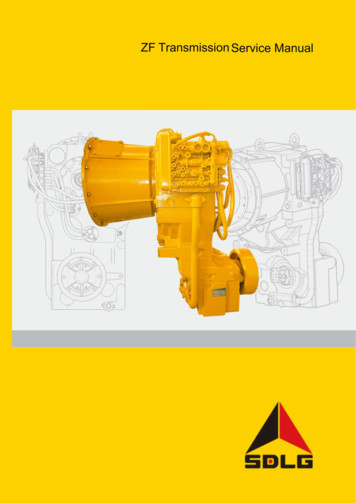POWER TRANSMISSION
POWER TRANSMISSIONThe following are the major types of power transmission.1 Belt drive, 2 Rope drive, 3 Chain drive, 4 Gear driveBELT DRIVE: - This type of drive is used when the power is to be transmitted from oneshaft to other which is at a distance. Pulleys are mounted on the driver anddriven/follower shafts and an endless belt are fitted tightly over these pulleys. Thefrictional resistance between these pulleys and belt is the reason for the powertransmission, which depends on the velocity of belt, tension of the belt and arc of contactof the belt in the smaller pulley. There are flat belt and V- belt used for the powertransmission.Open belt drive: - for parallel shafts and to be rotated in the same direction as that of thedriver shaft. The driver pulley pulls the belt from one side and delivers it to the otherside. The tension in the former side will be larger and hence called tight side and theother side where the tension is less is called slack side.Crossed belt drive: - when the driven shaft is to be rotated in the opposite direction asthat of the driver shaft, the belt is to be arranged in a crossed manner as shown in the fig.ROPE DRIVE: - cotton ropes of circular in cross section are used for powertransmission. They are arranged in groves of the pulley. The grove angle varies from 400to 600 . More than one drive can be taken is the main advantage. For transmitting largepower wire ropes are used.CHAIN DRIVES: -An endless chain running over toothed wheels mounted on the driverand driven shafts. The smaller wheel is called pinion and the other is called wheel. Thechain consists of plates; pins and bushes made of high-grade steel. There are hoistingchains and pulling chains apart from the power transmitting chains. Roller chains andsilent/inverted chains are the different types of power transmitting chains.GEAR DRIVES: -Toothed wheel is the gear for transmitting power between two shafts,which are very closer. The teeth of the gear mounted on the shaft meshes each otherduring rotation. Gears are manufactured either by milling, by casting or by hobbing. Spurgear, helical gear, bevel gear, worm gear are different types.Advantages of flat belt: 1.2.3.4.Used for high speed transmissionAbsorbs shock and vibrationUsed in industrial purposesLonger life when properly maintainedAdvantages of V- belt: -Advantages of rope drives1. Smooth and silent2. Less weight3. Shock resistant4. Longer lifeAdvantages of gear drives
1.2.3.4.Used for very high speed ratioWill not come out of groveMore drives can be taken from a single pulleyLow percentage slipsintersecting and nonAdvantages of chain drives1. High efficiency2. Less maintenance cost3. Very high accuracy4. Can be used for nonDisadvantages of chain drives1. Zero slip2. High efficiency3. Occupies less spacelength4. Can be operated at adverse tempmaintenance5. less load on shaft6. Can transmit power to several shafts-2-1. High cost2. More weight3. Velocity fluctuation due to change in4.Needaccuratemountingand
chain consists of plates; pins and bushes made of high-grade steel. There are hoisting chains and pulling chains apart from the power transmitting chains. Roller chains and silent/inverted chains are the different types of power transmitting chains. GEAR DRIVES: -Toothed whe
ZF Transmission Service Manual 5 2 Transmission System 2.1 Transmission Introduction 2.1.1 General Overview of the Transmission The ZF power gearshift transmission is composed of the hydraulic torque converter and rear-mounted countershaft transmission with multi-sheet friction clutch. The SDLG 938L、
Vice President and Head of Sales, Siemens Rajesh Narayan General Manager & Head Transmission Line BU, Power Transmission & Distribution, L&T Rajesh Narayan Head, Transmission Lines, Power Transmission & Distribution, L&T Construction Giridharan P Application Manager, Grid and Power Quality System
HVAC transmission lines such as greater power carrying capacity, the ability to connect asynchronous AC electric systems, precise control of electric power flow, and longer underground and undersea transmission lines. Typically, overall losses in HVDC transmission are 30-50% less than HVAC transmission [11]. Although HVDC incurs power losses
Electricity Transmission . discussion of state transmission policies. Because so many of these policies relate to permitting and siting transmission facilities, much of the policy discussion focuses on transmission siting. A Quick History . Growth of the Transmission System . The 19. th. century inventors who first began to harness electricity .
E4OD / 4R100 / C6 Rear connector on transmission AXOD / AXODE (AX4S) / AX4N Bottom connector on transmission CD4E Connector by pump, farthest from the bell housing of the transmission CHRYSLER PRODUCTS A500 / A518 / A618 Rear connector on the transmission A670 (A404) / A606 Top line on transmission
2) Medium transmission line – the line length is between 80km to 160 km 3) Long transmission line – the line length is more than 160 km Whatever may be the category of transmission line, the main aim is to transmit power from one end to another. Like other electrical system, the transmission network also will have
Jul 25, 2013 · 4 AGENDA Electricity Basics Types of transmission Characteristics of transmission Functions of transmission lines Role of transmission in the interconnected environment What determines power flow? Example of Line Flows Loop f
and Transmission Intercooled Petrol Engine Turbocharged Diesel Engine Turbocharged Diesel Engine Displacement (cc) 1390 1968 1968 Fuel-e ciency (km/l)* 14.69 19.33 16.96 Transmission 6-speed (Manual Transmission) 6-speed (Manual Transmission) 6-speed DSG (Automatic Transmission ) Performance Max. Power [PS (kW) @rpm] 122 (90) @ 5000 140 (103 .























